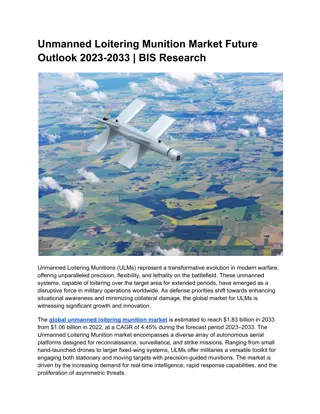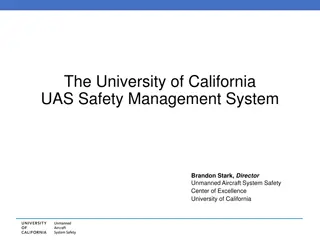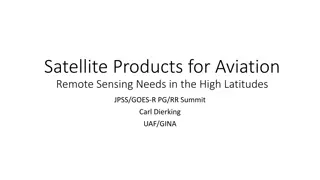Understanding Remote Identification of Unmanned Aircraft: Compliance Methods
The Final Rule on Remote Identification of Unmanned Aircraft introduces compliance methods for the model aircraft community to fly safely in national airspace. Explore the three ways to comply, including Standard Remote ID, Broadcast Modules, and FAA Recognized Identification Areas. Learn about registration requirements and explore options for recreational and educational operators. Stay informed about the changes affecting unmanned aircraft operations.
Download Presentation

Please find below an Image/Link to download the presentation.
The content on the website is provided AS IS for your information and personal use only. It may not be sold, licensed, or shared on other websites without obtaining consent from the author. Download presentation by click this link. If you encounter any issues during the download, it is possible that the publisher has removed the file from their server.
E N D
Presentation Transcript
Remote ID Overview & FAQs
Three Ways to Comply The passing of the Final Rule on Remote Identification of Unmanned Aircraft brings some changes to the model aircraft community and how we fly in the national airspace. There are three ways to comply with the new rule, outlined in the following slides.
Standard Remote ID 1 1. Identify both the UAS and control station Identify both the UAS and control station Broadcast equipment will be built into UAS at a manufacturer level, but likely will not apply to ARFs or kits. Requires radio frequency spectrum to broadcast location, altitude, ID, emergency status, etc. for both UA and control station. UAS designed not to take off if not broadcasting signal.
Broadcast Modules 2. Identify line 2. Identify line- -of of- -sight UAS operations sight UAS operations Module option allows for older (non- standard) UAS. Sends same signal as standard, except no emergency status and no control station information. The information broadcast will be UA take off location and altitude. Module also needs to signal if not working properly. FAA anticipates modules to cost $20-$50. Visual-line-of-sight operations only.
FAA Recognized Identification Areas 3. 3. Identify Community Identify Community- -Based Organization (CBO) locations with line (CBO) locations with line- -of of- -sight UAS operations operations Based Organization sight UAS Valid for 48 months and renewal/changeable forever. Requires site be under the umbrella of a CBO or educational institute. Visual line of sight operations only.
To register your aircraft, visit faadronezone.faa.gov. This is the only legitimate website to register your This is the only legitimate website to register your aircraft at. aircraft at. All other websites are scam websites. FAA Registration Requirement For assistance in registering your aircraft, AMA has provided a step-by-step walkthrough here, and a video walkthrough here. Registration will remain per individual at the cost of $5 $5 every three years. Standard Remote ID registration must include serial numbers of all aircraft so equipped. Broadcast module registration must include serial number of broadcast module. A screenshot of an airplane Description automatically generated with medium confidence
Events & Home Builds Home Builds Home Builds Events Events Recreational and educational operators can home build without meeting manufacturer certification standards, allowing these type of aircraft to be operated at an FAA Recognized Identification Area or under the Broadcast Model option. Special events, such as air shows or other temporary events, will have a path to receive authorization from the Administrator to deviate from the remote identification operating rules.
Timeline Each effective date begins after 60 days from publication in the federal register (December 28, 2020) (December 28, 2020)
Important Changes to Note From the Proposed Rule to the Final Rule Proposed Rule Proposed Rule Internet connectivity required Paid monthly subscription to UAS Service Supplier Final Rule Final Rule Broadcast only, no internet needed Requirement removed along with removal of internet connectivity FAA Recognized Identification Areas could only be requested in first year FAA Recognized Identification Areas can be requested or changed indefinitely Per aircraft registration Special events not addressed Individual registration, operator registers only one time Pathway for special events to deviate from Remote ID rules Included a 400ft range limit High cost associated with compliance Amateur built included a 50% build/fabrication requirement 400ft limit removed Cost decreased by 60% Build percentage requirement removed and home build was added with no requirement to meet manufacturer certification standards for recreational or educational use
FAQs Q: When will hobbyists need to comply with remote identification requirements? Q: When will hobbyists need to comply with remote identification requirements? A: Although you might notice new Remote ID products on the shelves and FAA-Recognized Identification Areas (FRIA) be established, operators are not required to comply until September 1, 2023. During this time, AMA will continue to shape the implementation of the rule for the hobby. Q: What is an FAA Recognized Identification Area (FRIA)? Q: What is an FAA Recognized Identification Area (FRIA)? A: An FRIA is a defined geographic area where persons can operate UAS without remote identification, provided they maintain visual line of sight. Q: Who can apply for a flying site to be an Q: Who can apply for a flying site to be an FRIA FRIA? ? A: Those eligible to request establishment of FRIAs include community-based organizations recognized by the Administrator and educational institutions. Q: How do I apply for my club s flying site to be an FRIA? Q: How do I apply for my club s flying site to be an FRIA? A: The process to apply for FRIA status will not begin until August 26, 2022. Once the details for the application process are released, we will inform our members of next steps. Q: Will FPV be permitted with the use of a broadcast module at established flying sites? Q: Will FPV be permitted with the use of a broadcast module at established flying sites? A: We interpret that FPV will continue to be permitted under any form of remote identification given legislation written in PL 115-254 Sect 349, defining visual line of sight operations.
Q: I mostly fly at my AMA clubs chartered flying site. How does this rule impact me? Q: I mostly fly at my AMA club s chartered flying site. How does this rule impact me? A: Clubs will be able to apply for their flying site to be recognized by the FAA through AMA. Once the flying site is included in the list of FAA Recognized Identification Areas, members can fly there without needing to meet any additional remote identification requirements. Q: I don t fly at an AMA chartered flying site. How does this rule impact me? Q: I don t fly at an AMA chartered flying site. How does this rule impact me? A: Those flying outside of an established flying site can meet the remote identification requirements by flying a Standard Remote ID equipped aircraft or an aircraft equipped with a broadcast module. Q: What changes are there to FAA registration? Q: What changes are there to FAA registration? A: All of the previous registration requirements in the proposed rule were removed in this final rule. You only have to register once every three years for $5, regardless of how many aircraft you own. Q: Do control line and free flight operators need to meet remote identification requirements? Q: Do control line and free flight operators need to meet remote identification requirements? A: AMA maintains that control line and free flight do not meet the definition of unmanned aircraft systems. Q: Will my Large Model Aircraft (LMA) need to comply with Remote ID requirements? Q: Will my Large Model Aircraft (LMA) need to comply with Remote ID requirements? A: Section 349 of Public Law 115-254 requires that LMA weighing over 55 lbs. be operated from fixed flying site locations. This likely means LMA will satisfy Remote ID by operating at a FRIA rather than broadcasting a radio frequency.























